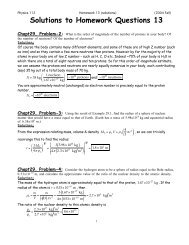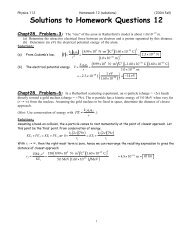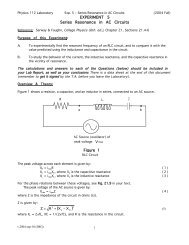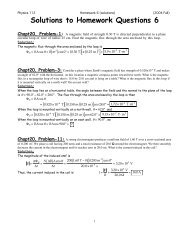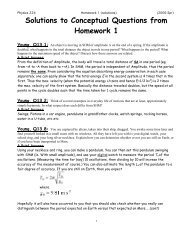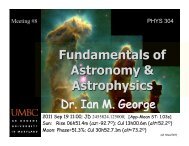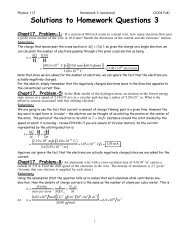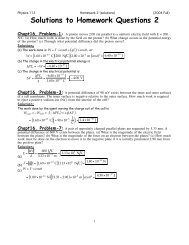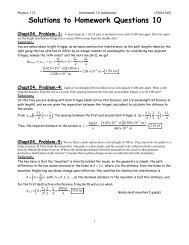Solutions to Homework Questions 1
Solutions to Homework Questions 1
Solutions to Homework Questions 1
You also want an ePaper? Increase the reach of your titles
YUMPU automatically turns print PDFs into web optimized ePapers that Google loves.
Physics 112 <strong>Homework</strong> 1 (solutions) (2004 Fall)<br />
<strong>Solutions</strong> <strong>to</strong> <strong>Homework</strong> <strong>Questions</strong> 1<br />
Chapt15, Problem-1: A 4.5 x 10 –9 C charge is located 3.2 m from a –2.8 x 10 –9 C charge. Find<br />
the electrostatic force exerted by one charge on the other.<br />
Solution:<br />
Since the charges have opposite signs, the force is !attractive .<br />
The magnitude so the force is given by Coulomb’s Law, so making the substitutions we get<br />
F = k e q 1 q 2<br />
#<br />
r 2 = 8.99 ! 10 9 N "m2 & ( 4.5 ! 10 )9 C) ( 2.8! 10 )9 C)<br />
%<br />
$<br />
C 2 (<br />
' 3.2 m<br />
( ) 2 = 1.1! 10"8 N<br />
Chapt15, Problem-3: An alpha particle (charge = +2.0e) is sent at high speed <strong>to</strong>ward a gold<br />
nucleus (charge = +79e). What is the electrical force acting on the alpha particle when it is 2.0 x 10 –14 m<br />
from the gold nucleus?<br />
Solution:<br />
Since the charges have opposite signs, the force is !repulsive<br />
The magnitude so the force is given by Coulomb’s Law, so making the substitutions we get<br />
F = k e( 2 e) ( 79 e)<br />
r 2<br />
#<br />
= 8.99 ! 10 9 N "m2 &<br />
%<br />
$<br />
C 2 (<br />
'<br />
( ) 2<br />
( 2.0!10 )14 m) 2 =<br />
( 158) 1.60 !10 )19 C<br />
91 N ( repulsion)<br />
Chapt15, Problem-5: The nucleus of 8 Be, which consists of 4 pro<strong>to</strong>ns and 4 neutrons, is very<br />
unstable and spontaneously breaks in<strong>to</strong> two alpha particles (helium nuclei, each consisting of 2 pro<strong>to</strong>ns and<br />
2 neutrons). (a) What is the force between the two alpha particles when they are 5.00 x 10 –15 m apart, and (b)<br />
what will be the magnitude of the acceleration of the alpha particles due <strong>to</strong> this force? Note that the mass of<br />
an alpha particle is 4.0026 u.<br />
Solution:<br />
Since the charges have opposite signs, the force is !repulsive<br />
The magnitude so the force is given by Coulomb’s Law, so making the substitutions we get<br />
*<br />
(a) F = k e ( 2e)2<br />
r 2 = 8.99 !10 9 N "m2<br />
4 1.60 !10 )19 2<br />
#<br />
C &<br />
-<br />
#<br />
&<br />
, $<br />
' /<br />
+ ,<br />
./<br />
%<br />
$<br />
C 2<br />
(<br />
' 5.00 ! 10 )15 =<br />
2<br />
36.8 N<br />
#<br />
$<br />
m&<br />
'<br />
(b) The mass of an alpha particle is m = 4.0026 u , where u = 1.66! 10 "27 kg is the unified mass unit.<br />
Applying New<strong>to</strong>n’s 2 nd law, the acceleration of either alpha particle is then<br />
a = F m = 36.8 N<br />
4.0026 1.66 !10 "27 kg<br />
( ) = 5.54 !1027 ms 2<br />
Of course from New<strong>to</strong>n’s 3rd law, both alpha particles experience the same force, and hence undergo the<br />
same acceleration.<br />
1
Physics 112 <strong>Homework</strong> 1 (solutions) (2004 Fall)<br />
Chapt15, Problem-7: Suppose that 1.00 g of hydrogen is separated in<strong>to</strong> electrons and pro<strong>to</strong>ns.<br />
Suppose also that the pro<strong>to</strong>ns are placed at Earth’s North Pole and the electrons are placed at the South<br />
Pole. What is the resulting compressional force on Earth?<br />
Solution:<br />
1.00 g of hydrogen contains Avogadro’s number of a<strong>to</strong>ms, each containing one pro<strong>to</strong>n and one electron. Thus,<br />
each charge has magnitude q = N A e . The distance separating these charges is r = 2 R E , where R E is the<br />
Earth’s radius. Thus applying Coulomb’s Law,<br />
F = k e( N A e ) 2<br />
( 2 R E ) 2<br />
#<br />
= 8.99 ! 10 9 N "m2 & ( 6.02 !10 23<br />
)1.60 ! 10 )19 C<br />
%<br />
$<br />
C 2 (<br />
' 4 6.38 ! 10 6 m<br />
[ ( )] 2<br />
( ) 2 = 5.12 !105 N<br />
Chapt15, Problem-8: An electron is released a short distance above Earth’s surface. A second<br />
electron directly below it exerts an electrostatic force on the first electron just great enough <strong>to</strong> cancel the<br />
gravitational force on it. How far below the first electron is the second?<br />
Solution:<br />
The magnitude of the repulsive force between electrons must equal the weight of an electron, Thus by<br />
using Coulomb;’s Law and New<strong>to</strong>n’s 2 nd Law (applied <strong>to</strong> gravity), we have<br />
k e e 2 r 2 = m e g<br />
so rearranging this expression, and then making the substitutions, we get<br />
r =<br />
( )( 1.60 !10 #19 C ) 2<br />
( )( 9.80 m s 2<br />
)<br />
k e e2<br />
m e<br />
g = 8.99 !10 9 N" m 2 C 2<br />
9.11 !10 #31 kg<br />
Chapt15, Problem-11: Three charges are arranged<br />
as shown in Figure P15.11. Find the magnitude and direction<br />
of the electrostatic force on the charge at the origin.<br />
Solution:<br />
In the sketch <strong>to</strong> the right, F R is the resultant of the<br />
forces F 6 and F 3 that are exerted on the charge at<br />
the origin by the 6.00 nC and the –3.00!nC charges<br />
respectively. Applying Coulomb’s Law <strong>to</strong> each, we get<br />
#<br />
F 6<br />
= 8.99 !10 9 N" m 2 & 6.00 !10 )9 C<br />
%<br />
$<br />
C 2 (<br />
' 0.300 m<br />
= 3.00! 10 )6 N<br />
#<br />
F 3 = 8.99 !10 9 N" m 2 &<br />
%<br />
$<br />
C 2 (<br />
'<br />
( )( 5.00 !10 )9 C )<br />
( ) 2<br />
( 3.00! 10 )9 C) 5.00 ! 10 )9 C<br />
( )<br />
0.100 m<br />
From the Superposition Principle, the resultant is<br />
F R = ( F 6 ) 2 #<br />
+ F 3<br />
%<br />
$<br />
( ) 2 = 1.38 !10 "5 N at ! = tan "1 F 3<br />
or F R = 1.38 !10 "5 N at 77.5° below " x axis<br />
= 5.08 m<br />
( ) 2 = 1.35! 10 )5 N<br />
F 6<br />
&<br />
( = 77.5° ,<br />
'<br />
F 6<br />
5.00 nC<br />
!<br />
F R<br />
F 3<br />
0.300 m<br />
0.100 m<br />
-3.00 nC<br />
6.00 nC<br />
2
Physics 112 <strong>Homework</strong> 1 (solutions) (2004 Fall)<br />
Chapt15, Problem-13: Three point charges are located<br />
at the corners of an equilateral triangle as in Figure P15.13.<br />
Calculate the net electric force on the 7.00 µC charge.<br />
Solution:<br />
The forces on the 7.00 µC charge are shown in the sketch <strong>to</strong><br />
the right. Applying Coulomb’s Law <strong>to</strong> calculate each force,<br />
we get<br />
#<br />
F 1<br />
= 8.99! 10 9 N "m 2 &<br />
%<br />
$<br />
C 2 (<br />
'<br />
= 0.503 N<br />
#<br />
F 2<br />
= 8.99 !10 9 N" m 2 &<br />
%<br />
$<br />
C 2 (<br />
'<br />
= 1.01 N<br />
From the superposition principle, we known<br />
!F x = ( F 1 + F 2 )cos 60.0°=0.755 N ,<br />
and !F y = ( F 1 " F 2 )sin 60.0°="0.436 N<br />
( 7.00! 10 )6 C) 2.00 ! 10 )6 C<br />
( )<br />
0.500 m<br />
( ) 2<br />
( 7.00 !10 )6 C) 4.00 ! 10 )6 C<br />
( )<br />
0.500 m<br />
( ) 2<br />
So the resultant force on the 7.00 mC charge is<br />
F R =<br />
or F R =<br />
60.0°<br />
( ) 2 $ #F<br />
= 0.872 N at ! = tan "1 y '<br />
& ) = "30.0° ,<br />
% #F x (<br />
0.872 N at 30.0° below the + x axis<br />
6.00 nC –3.00 nC<br />
0.600 m<br />
x<br />
( )q<br />
x 2 , or 2 x 2 = ( x + 0.600 m ) 2<br />
2 ! 1 = 1.45 m beyond the - 3.00 nC charge<br />
(!F x ) 2 + !F y<br />
Chapt15, Problem-16: A charge of 6.00x10 –9 C and a charge of<br />
–3.00x10 –9 C are separated by<br />
a distance of 60.0 cm. Find the position at which a third charge of 12.0 x 10 –9 C can be placed so that the<br />
net electrostatic force on it is zero.<br />
Solution:<br />
The required position is shown in the<br />
sketch <strong>to</strong> the right. Note that this places q<br />
closer <strong>to</strong> the smaller charge, which will<br />
allow the two forces <strong>to</strong> cancel. Applying Coulmob’s<br />
Law, and requiring that F 6 = F 3 gives<br />
k e ( 6.00 nC )q<br />
( x + 0.600 m ) 2 = k e 3.00 nC<br />
Solving for x gives the equilibrium position as<br />
x = 0.600 m<br />
y<br />
F 1<br />
+ 7.00 µC<br />
F 2<br />
x<br />
+<br />
2.00 µC 0.500 m<br />
–<br />
-4.00 µC<br />
F 3<br />
q<br />
F 6<br />
3
Physics 112 <strong>Homework</strong> 1 (solutions) (2004 Fall)<br />
Chapt15, Problem-19: An airplane is flying through a thundercloud at a height of 2 000 m.<br />
(This is a very dangerous thing <strong>to</strong> do because of updrafts, turbulence, and the possibility of electric<br />
discharge.) If there are charge concentrations of +40.0 C at height 3 000 m within the cloud and –40.0 C at<br />
height 1 000 m, what is the electric field E at the aircraft?<br />
Solution:<br />
We shall treat the concentrations as point charges. Then, the resultant field consists of two contributions,<br />
one due <strong>to</strong> each concentration.<br />
The contribution due <strong>to</strong> the positive charge at 3000 m altitude is<br />
q<br />
E + = k e<br />
r 2 = #<br />
8.99 N" m 2 & ( 40.0 C)<br />
%<br />
$<br />
!109 C 2 (<br />
' 1000 m<br />
( ) 2 = 3.60 !105 NC ( downward)<br />
The contribution due <strong>to</strong> the negative charge at 1000 m altitude is<br />
q<br />
E ! = k e<br />
r 2 = $<br />
8.99 N# m 2 ' ( 40.0 C)<br />
&<br />
%<br />
"109 C 2 )<br />
( 1000 m<br />
( ) 2 = 3.60 "105 NC ( downward)<br />
From the Superposition Principle, the resultant field is then<br />
E = E + + E ! = 7.20 !10 5<br />
( )<br />
N C downward<br />
Chapt15, Problem-27: In Figure P15.27,<br />
determine the point (other than infinity) at which<br />
the <strong>to</strong>tal electric field is zero.<br />
Solution:<br />
If the resultant field is zero, the<br />
contributions from the two charges must<br />
be in opposite directions and also have<br />
equal magnitudes. Choose the line<br />
connecting the charges as the x-axis, with<br />
the origin at the –2.5!µC charge. Then, the<br />
two contributions will have opposite<br />
r 2 = 1.0 m + d<br />
directions only in the regions x < 0 and<br />
x > 1.0 m . For the magnitudes <strong>to</strong> be equal, the point must be nearer the smaller charge. Thus, the point of<br />
zero resultant field is on the x-axis at x < 0.<br />
Requiring equal magnitudes gives k e q 1<br />
r 1<br />
2<br />
= k e q 2<br />
r 2<br />
2<br />
or<br />
Thus, ( 1.0 m + d)<br />
2.5<br />
6.0 = d<br />
r 1 = d<br />
1.0 m<br />
+x<br />
E2 E 1 q 1 = –2.5 µC q 2 = 6.0 µC<br />
2 .5 µC<br />
d 2 =<br />
6.0 µC<br />
( 1.0 m + d) 2 .<br />
Solving for d yields d = 1.8 m , or 1.8 m <strong>to</strong> the left of the ! 2 .5 µC charge<br />
+y<br />
4
Physics 112 <strong>Homework</strong> 1 (solutions) (2004 Fall)<br />
Chapt15, Problem-28: Figure P15.28 shows<br />
the electric field lines for two point charges separated<br />
by a small distance. (a) Determine the ratio q 1 /q 2 . (b)<br />
What are the signs of q 1 and q 2 ?<br />
Solution:<br />
The magnitude of q 2 is three times the magnitude of q 1<br />
because 3 times as many lines emerge from q 2<br />
as enter q 1 . q 2 = 3 q 1<br />
(a) Then, q 1 q 2 =!1 3<br />
(b)<br />
q 2 > 0 because lines emerge from it,<br />
and q 1 < 0 because lines terminate on it<br />
Chapt15, Problem-35: If the electric field strength in air exceeds 3.0 x 10 6 N/C, the air becomes a<br />
conduc<strong>to</strong>r. Using this fact, determine the maximum amount of charge that can be carried by a metal sphere<br />
2.0 m in radius.<br />
Solution:<br />
For a uniformly charged sphere, the field is strongest at the surface.<br />
Thus, E max = k e q max<br />
R 2 ,<br />
or<br />
q max = R2 E max<br />
k e<br />
( )<br />
( ) 2 3.0 !10 6 NC<br />
= 2.0 m<br />
8.99 !10 9 N" m 2 C 2 = 1.3 !10 "3 C<br />
Chapt15, Problem-41: A 40-cm-diameter loop is rotated in a uniform electric field until the<br />
position of maximum electric flux is found. The flux in this position is measured <strong>to</strong> be 5.2 x 10 5 N · m 2 /C.<br />
Calculate the electric field strength in this region.<br />
Solution:<br />
From the definition of Electric Flux ! E = EAcos" and ! E = ! E, max when ! = 0°<br />
Thus, E = ! E, max<br />
A<br />
( )<br />
= ! E, max<br />
"d 2 4 = 4 5.2 #105 N$ m 2 C<br />
" 0.40 m<br />
( ) 2 = 4.1! 106 NC<br />
5
Physics 112 <strong>Homework</strong> 1 (solutions) (2004 Fall)<br />
Chapt15, Problem-57: Two 2.0-g spheres are suspended by<br />
10.0-cm-long light strings (Fig. P15.57). A uniform electric field is<br />
applied in the x direction. If the spheres have charges of –5.0 x 10 –8 C<br />
and +5.0 x 10 –8 C, determine the electric field intensity that enables<br />
the spheres <strong>to</strong> be in equilibrium at ! = 10°.<br />
Solution:<br />
The sketch <strong>to</strong> the right gives a free-body diagram of the<br />
positively charged sphere. Here, F 1 = k e q 2 r 2 is the attractive<br />
force exerted by the negatively charged sphere and F 2 = qE<br />
is exerted by the electric field.<br />
!F y = 0 " T cos10°=mg or T = mg<br />
cos 10°<br />
!F x = 0 " F 2 = F 1 +T sin10° or qE= k e q 2<br />
r 2<br />
+ mg tan10°<br />
10° y<br />
T<br />
x<br />
At equilibrium, the distance between the two spheres is r = 2( Lsin 10° ).<br />
Thus,<br />
E =<br />
k e<br />
q<br />
4( Lsin 10° )<br />
mg tan10°<br />
2<br />
+<br />
q<br />
F 1<br />
mg<br />
F 2<br />
( )( 5.0 !10 #8 C)<br />
= 8.99 ! 109 N"m 2 C 2<br />
4 ( 0.100 m)sin10°<br />
( ) 9.80 m s 2<br />
( 5.0 !10 #8 C)<br />
[ ] 2 + 2.0 !10 #3 kg<br />
and so the electric field strength required is E = 4.4 !105 NC .<br />
( )tan10°<br />
,<br />
Chapt15, Conceptual-2: Hospital personnel must wear special conducting shoes when they work<br />
around oxygen in an operating room. Why? Contrast with what might happen when personnel wear rubbersoled<br />
shoes.<br />
Solution:<br />
To avoid making a spark. Rubber-soled shoes acquire a charge by friction with the floor and could discharge<br />
with a spark, possibly causing an explosive burning situation, where the burning is enhanced by the oxygen.<br />
Chapt15, Conceptual-12: Is it possible for an electric field <strong>to</strong> exist in empty space? Explain<br />
Solution:<br />
An electric field once established by a positive or negative charge extends in all directions from the<br />
charge. Thus, it can exist in empty space if that is what surrounds the charge.<br />
Chapt15, Conceptual-14: Would life be different if the electron were positively charged and the<br />
pro<strong>to</strong>n were negatively charged? Does the choice of signs have any bearing on physical and chemical<br />
interactions? Explain<br />
Solution:<br />
No. Life would be no different if electrons were positively charged and pro<strong>to</strong>ns were negatively charged.<br />
Opposite charges would still attract, and like charges would still repel. The designation of charges as<br />
positive and negative is merely a definition.<br />
6
Physics 112 <strong>Homework</strong> 1 (solutions) (2004 Fall)<br />
Chapt15, Conceptual-16: Why should a ground wire be connected <strong>to</strong> the metal support rod for<br />
a television antenna?<br />
Solution:<br />
The antenna is similar <strong>to</strong> a lightning rod and can induce a bolt <strong>to</strong> strike it. A wire from the antenna <strong>to</strong> the<br />
ground provides a pathway for the charges <strong>to</strong> move away from the house in case a lightning strike does<br />
occur.<br />
7







